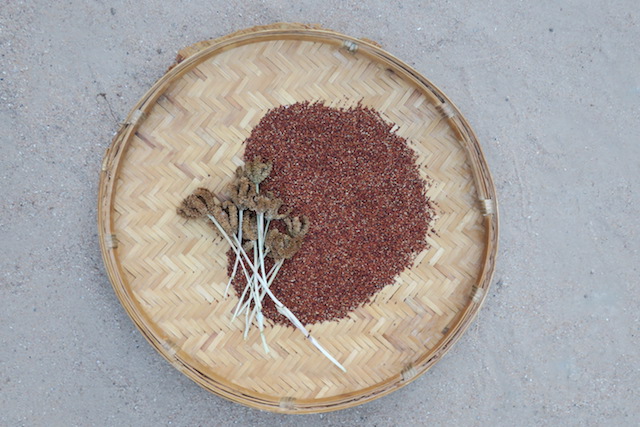The next year we planted finger millet, which is called njera. And we had a very good yield. It took us two days to thresh it. So we had enough food, and that’s when we said, “Oh, we have something to eat now!” That was in 1948.
Njera is similar to another weed, which we call sawi. You might say it’s the same, but it’s not. We have to see the difference in the grains. Sawi has very very tiny grains, and njera grains are a little bit bigger, like rape seeds. So we don’t want sawi growing there, because sawi is very, very hard and it’s very, very strong.
Let’s say you are coming from here, and you have never been farming. If you go there, we don’t put you there, because you don’t know the difference. Older people, men and women, they must know. But we don’t take kids to go weed the njera, because they don’t know. Otherwise they might weed the njera out instead of the sawi, or they might leave sawi together with njera.
We start harvesting njera between the end of April and August. When it begins turning red, then we have to check. When we see the nhunguru fruits are ripening, the njera will also be maturing. It will be turning red. So, that changing color, we must then hurry to cut it, because its stalks are quick to weaken. And then, once they become desiccated, they collapse downward. So, we must hurry and cut it, otherwise the millet seeds will be lost on the ground.
When we are harvesting njera we find something called nhingetinge. Nhingetinge is when you find a stalk of millet that is different than the other stalks. Most of the stalks grow straight, bearing a single head of millet. Nhingetinge is when the stalk splits. Maybe you find it bearing two heads of millet, or even three. So, that is nhingetinge. When you find it, you cry out the name of the person closest to you, and call out to him, saying, “Nhingetinge!” Once you call out, he must reply, “You see one! Where?” And once he replies, now he owes you something. He must give you something, because you’ve called to him by name to tell him you found nhingetinge.
We have to thresh the njera, because that’s how we take out the grains. When we do that, we have to ask people in the villages to come and help us. Then we cook sadza and kill chickens for people to eat. If you have a goat, you kill the goat, and people eat it. Then, they spend the day threshing the njera with sticks.
When we thresh, we sing the same song, all of us singing at once. Women on one side, and men on the other. So we are on opposite sides, but working together. The songs – you know, they’re weird. They are embarrassing! When we sing we don’t care, “There’s my mother-in-law,” or “There’s my mother,” or, “There’s whoever.” We just sing:
Kwe kwe Kwe kwe
A kwe a kwe A kwe a kwe
Beche makanda The cunt is flaps of skinKwe kwe Kwe kwe
A kwe a kwe A kwe a kwe
Mboro makanda The cock is flaps of skin
That is the song I remember, because people were mostly concentrating on that song. Because it is funny. You know, when you are in a group mixed with women and men, they both have to sing. Women have to sing for men, and men have to sing for women. So they work hard there – they don’t feel tired. When children are there, they have to sing, too. But when they move from there, they are not allowed to say that.

